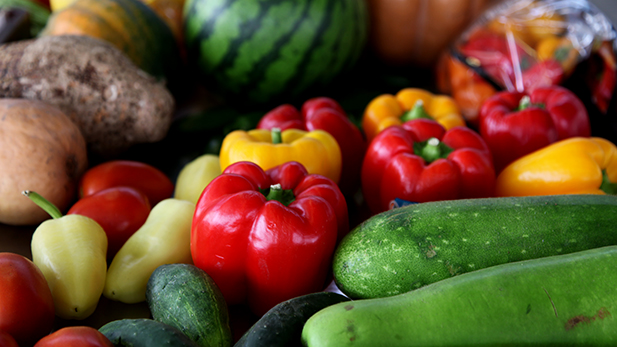 Produce inspected at the Mariposa Port of Entry in Nogales, Az. (2015)
Produce inspected at the Mariposa Port of Entry in Nogales, Az. (2015)Listen:
Most days, up to 1,600 trucks pass through the Mariposa Port of Entry in Nogales
Many are loaded with fresh produce grown in the fields of western Mexico, accounting for more than a third of all produce imports from the U.S.’s southern neighbor.
“Some of the largest commodities we see by volume are going to be the watermelons, squashes, tomatoes, cucumbers,” said Anne Crowther, an agricultural specialist with Customs and Border Protection.
It amounts to billions of pounds of produce each year and that number is growing.
On a typical day, between 50 and 100 trucks will be asked to back up to the docks at Mariposa, where their trailers are emptied and the cargo is inspected.
The check isn’t just to ensure there’s no illegal contraband in the shipment.
Any organic material that comes in on that sample of trucks will be looked over for signs of invasive insects and disease.
That includes the produce, wood pallets, cardboard packaging and dirt that fell off the produce.
“A lot of times when the truck is moving and things are shifting, they’ll fall into the crate or the box,” Crowther said. “You’ll also remove the commodity from the box and look in the box to see if anybody has been jarred loose.”
Inspections aren’t random. Agents at the port follow rules that rank the risk a certain kind of produce has of carrying invasive species.

For example, fruits with hard skins such as watermelon or pumpkins are less likely to be inspected than soft-skinned tomatoes and squash.
“If a commodity is known to harbor pests, sometimes it’s required that we cut it,” Crowther said. “The oranges, the citrus, the mangoes, stuff like that is going to be sliced open, and the inside of the fruit is going to be inspected.”
A typical top-to-bottom inspection takes between 45 minutes and an hour, according to Emilio Vasquez, the Agricultural Chief of the Port of Nogales
But other trucks go through a less-detailed 20 to 30 minute inspection.
The quicker ‘tailgate inspection’ when agents open a truck’s cargo container and make sure the cargo in the back is the same as what is listed on the truck driver’s paperwork.
Vasquez estimated four or five trucks a day are flagged by Customs and Border Protection and held for further inspection by the U.S. Department of Agriculture.
A failed inspection on that level can mean the produce is refused entry into the country or is required to undergo fumigation.
Trucks denied entry make up a small part of a growing industry.
Mexican produce crossings at Mariposa have topped 4 billion pounds each of the last two growing seasons.

A recent port expansion has helped Customs meet demand better.
“It’s been a lot smoother,” Vasquez said. “We’re able to handle the amount of trucks. Last week we had over 1,600 trucks some of the days.”
The next step for Customs and Border Protection to streamline operations at the Port of Mariposa is adding staff.
The agency wants to hire more than 100 new inspectors between the Mariposa and DeConcini ports of entry in Nogales.
And that could mean the coming years see the amount of produce that hits American plates after going through Mariposa continue to grow.

By submitting your comments, you hereby give AZPM the right to post your comments and potentially use them in any other form of media operated by this institution.